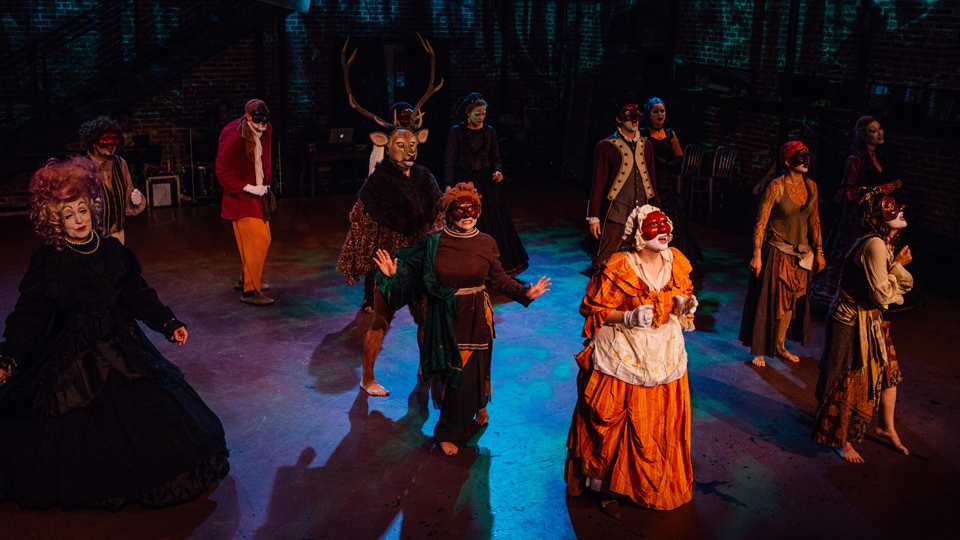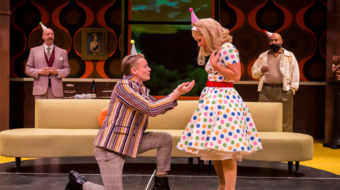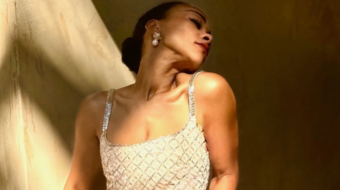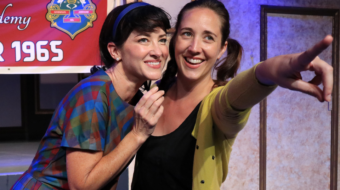
CULVER CITY, Calif.—Set circa 1530 in Italy, The Actors’ Gang’s Harlequino: On to Freedom takes place when commedia dell’arte emerged as an important form of theatre. Cihan Sahin’s projections of the era’s artwork, Olivia Courtin’s costumes, and original music composed by writer/director Tim Robbins, sung by the company and performed by a live band (with Ara Dabanjian on mandolin), conjure up 16th-century Europe during what was called the “Counter-Reformation,” when the traditional Roman Catholic church rejected Protestant changes advocated by Martin Luther and his followers.
Commedia’s colorful, costumed, often masked actors portrayed stock characters in frequently funny sketches, the jokes coming at the expense of the rich and powerful. The troupe of jesters’ dramatis personae include Harlequino (Joshua R. Lamont), a quick-witted servant, who undermines and outsmarts his master, Pantalone (Pierre Adeli), especially when it comes to pursuing matters of the heart at the expense of his “superior’s” conspiring to profiteer via cunning matchmaking.
Harlequino’s playwright upends conventional notions of this epoch and its theater by making the protagonist, Harlequino, Black. The African slave trade had already begun and the comedy (albeit with serious undertones) contends something I’d never heard before: That by this time there were already 100,000 enslaved Africans in Europe. So even back then Black Lives Mattered.
Not content to make a political point, Robbins’ script subverts esthetics too, as the commedia players also rebel against genre conventions as laid down by the doctrinaire, dogmatic “experts,” Dr. Phineus Preamble (Will McFadden) and Dr. Ignatius Afterword (Bob Turton). Depicted as “drolly-poly” pompous buffoons seeking to impose their canon on the free-spirited actors and their artistry, these would-be censors are reminiscent of Candide’s know-it-all know-nothing, Professor Pangloss, in Voltaire’s 1759 satire of the Enlightenment.
Playing against type and resisting the imposition of restrictions upon their creativity mirror the characters’ struggle to freely love whom they please, as Pantalone endeavors to block Harlequino’s affection and lust for Columbina (the zaftig Sabra Williams in mime-like white makeup) and to marry his daughter Isabella (Lee Margaret Hanson) off to Capitano, a swordsman of stature whose social status in this pecking order is far higher than that of Isabella’s beloved, Mario (in a double role, Adam Jefferis cleverly plays both Mario and his arch-rival, Capitano).
Mario and Isabella’s on-again, in- and out-again tempestuous romance is rather hilariously portrayed. The two-acter is rendered with much tomfoolery and comic panache, as—talk about transgressing and transcending categorical boundaries—The Actors’ Gang tosses other genres into the commedia stew: vaudeville, burlesque and physical comedy in the tradition of silent cinema. In commedia dell’arte the Harlequino stock character often used pantomime, as does the talented, masked Lamont in the title role.
But beneath the mirth and merriment The Gangsters are skewering and scoring important points. At the heart of the saga, Lamont told me during the reception in the Ivy Substation’s patio after the show, is whether “Harlequino is free or a slave?” Is he fully human? By making this stock character Black, Robbins raises the proverbial ante.
As the late Nobel Prize-winning Italian playwright Dario Fo, a Robbins mentor, noted: “Commedia dell’arte’s jesters were talking newspapers” for Europe’s illiterate masses, who “helped raise people’s awareness. The jesters were liked by the poor, by the common people, but they were hated, feared and despised by those in power.” (Something like Saturday Night Live today, perhaps?)
During the Depression, the U.S.-government subsidized The Living Newspaper productions that dramatized headlines ripped from the front pages as part of the Works Progress Administration’s Federal Theatre Project. The best film dramatization I’ve seen of the WPA-supported proletarian theatre was in the movie Cradle Will Rock, about the radical 1937 pro-labor musical by Marc Blitzstein, directed by Orson Welles, which was shut down at bayonet point on Broadway. This stellar 1999 film was written/directed by none other than The Actors’ Gang’s Artistic Director—Tim Robbins.
At the post-play reception I asked Tim why he has been so enamored of commedia dell’arte, whose leitmotifs reappear in his stage work. The Oscar winner replied, “Because it’s the people’s theatre. They’d perform out in the streets, the public square—then they’d get the fuck out of town.” Robbins added that there had to be some reason why Duke Gonzaga of Mantua ordered the executions of three actors after a commedia company’s performance. Robbins’ stage and screen work has often leaned left and he’s no stranger to the subversive, as in The Gang’s productions of the bold Iraq War farce Embedded (written/directed by Robbins) and The Trial of the Catonsville Nine, a docu-play about the militantly pacifist, prophetic Berrigan Brothers. As I recall, novelist/essayist Gore Vidal introduced Catonsville on opening night.
At Harlequino’s U.S. premiere L.A. Mayor Eric Garcetti and Culver City Mayor Jim Clarke were in the audience. Although Harlequino puts the playful into play and is heaps of inventive fun, it’s not for everyone. The show can be quite bawdy and naughty, with elaborate descriptions of impotence and explicit sexual activity, so you might want to leave the kiddies at home. But those who get into the spirit will likely have a rollicking good time, leavened not only with levity but with ruminations on man’s—and woman’s—eternal struggle to be free.
The Actors’ Gang’s Harlequino: On to Freedom plays at the Ivy Substation, 9070 Venice Blvd., Culver City 90232 on Thurs. and Sat. at 8:00 pm and Fri. at 9:00 pm through May 6. For more info: (310) 838-GANG; www.theactorsgang.com.
Ed Rampell co-presents Esther Shub’s documentary The Fall of the Romanovs on Fri., April 28 at 7:30 pm at The L.A. Workers Center, 1251 S. St. Andrews Place, L.A. 90019 as part of the ongoing “Ten Films That Shook the World” series celebrating the centennial of the Russian Revolution, the fourth Friday of each month through November. For info: laworkersedsoc@gmail.com.










